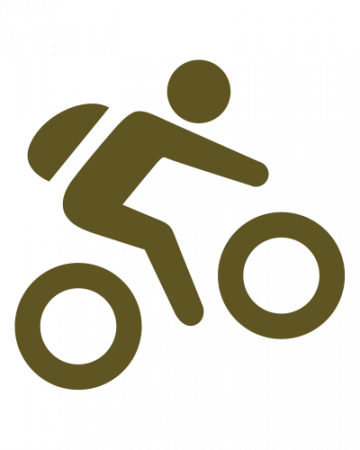Mountain Biking
Leave No Trace Mountain Biking
Plan Ahead and Prepare
- Ensure your mountain bike is in good, working order. A properly maintained mountain bike reduces the risk of injury, a long walk out, or both.
- Check with land managers, local bike shops, local cycling groups, and www.mtbproject.com for the most up-to-date trail information.
- When riding in popular areas or at peak times, keep groups small.
- Be self-sufficient and pack appropriately. A rain shell, multi-tool, spare tube, pump, and food all help ensure a safe and fun ride
- Wear a helmet and other appropriate safety gear. It could save your life.
Travel on Durable Surfaces
- For biking, durable surfaces include established trails, authorized slickrock areas, dirt roads, and pavement. Check local regulations to see if off-trail travel by bike is allowed.
- Respect trail and road closures. Do not trespass on private land, and obtain permits to ride when necessary.
- Avoid riding muddy, excessively wet, or city trails. When encountering patches of mud or ice, ride through it and not around to avoid trail widening.
- Avoid skidding. Locking up your tires creates ruts or break bumps, increases erosion, and decreases your control.
- Take someone new for a ride and teach him or her proper trail riding technique.
Dispose of Waste Properly
- Pack it in, pack it out. Litter can potentially endanger wildlife, attract scavengers, and diminish other visitors' experiences. This includes toilet paper and other hygiene products.
- Designate a pocket for litter, wrappers, and leftover food.
- Use restroom facilities before hitting the trail. Otherwise, deposit solid human waste in catholes dug 6 to 8 inches deep at least 200 feet from water, camp, and trails. Cover and disguise the cathole when finished.
- Urinate well away from water sources and out of sight of others.
- Be cool. Leave a favorable impress, not waste.
Leave What You Find
- Preserve the past: observe, but do not touch, cultural or historic structures and artifacts. Leave rocks, plants and other natural objects as you find them.
- #mtbselfie: photograph yourself being a responsible mountain biker; take pictures of natural objects in the wild and leave them for future preservation.
- Avoid introducing or transporting non-native species. Check your clothing, bike, and equipment before and after each ride for seeds. Wash your bike between rides.
- Do not engage in unauthorized trailwork. Instead, look for opportunities to work on land manager-approved projects. You could unknowingly damage sensitive vegetation or contribute to further erosion and other trail damage.
Respect Wildlife
- Stick to the trail. Wildlife accustomed to riders can predict actions, but riding off-trail confuses wildlife.
- Observe wildlife from a distance. Do not follow or approach them.
- Never feed animals. Feeding wildlife damages their health, alters natural behaviors, and exposes them to predators and other dangers.
- Control pets at all times, or leave them at home.
- Avoid wildlife during sensitive times: mating, nesting, winter, dusk, and dawn.
Be Considerate of Other Visitors
- Respect other trail users and protect the quality of their experience. Always ride within your limits.
- Be courteous. Yield to hikers and equestrians. Be prepared to stop and dismount if the trail is narrow or crowded. Yield to climbing cyclists when descending.
- When encountering slower traffic, announce your presence with a friendly greeting or bell and avoid startling other visitors.
- Reduce your potentially intimidating size by stepping to the downhill side of the trail when encountering pack stock.
- Ride in small groups to avoid excessive dust and noise..
- Racing on open trails can be dangerous and inconsiderate. Save your "beast mode" for race day between the tape.

